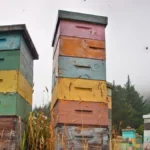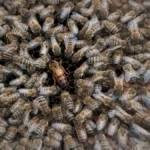At some point as beekeepers, we are tempted to ask when to add a second brood box? Adding a second brood box has benefits and also can introduce certain complications. We will have a look at the pros and cons of this practice in this article.
The Bee Brood Box
The brood box is typically the first box after the bottom board in the hive. In this box, the bees raise brood and normally will have some pollen and nectar stores. A queen bee, during peak conditions, can lay thousands of eggs per day. Depending on which race of bees you have, the number of cells on a brood frame will vary. With the larger European bee races, there are considerably fewer cells on a frame than smaller races such as African bees.
Typically, beekeepers will place a queen excluder on top of the brood box, and then place honey supers above this. This management tool ensures that the brood is confined to the brood area. It also allows a beekeeper to direct resources into the honey gathering side of operations. If you know your area, your bees, and your honey flows, you can explore adding a second brood box.
When To Add A Second Brood Box
In certain parts of the world, if you know you have a very strong honey flow coming, it can be advantageous to allow your bees to move into a second brood box. This will allow the hive to increase numbers and take advantage of a big upcoming flow. If you know you have a good strong queen, then you can add a second brood box.
In some cases, beekeepers will add a second brood box and not use a queen excluder. They will just stack supers on top of this brood box once it is full, and allow the bees to manage the size of their brood nest. If you have abundant nectar, and bees that are not inclined to swarm, this method can result in very strong hives and very large crops of honey.
Adding A Second Brood Box To Make Strong Splits
In some parts of the world, I have seen beekeepers add a second brood box in spring, allow the bees to move into this, and then make splits by splitting the second brood box and moving this to a new apiary. Often these beekeepers do this early in spring, and then requeen the hives to control swarming.
I have made splits in this way and found it to produce strong hives. I do prefer splitting smaller hives with nucleus boxes as it is less stressful.

Read more about: Splitting A Hive To Prevent Swarming
How Many Brood Boxes Should A Hive Have?
In the areas where I have kept bees, I have found one brood box and a queen excluder produce the best average honey yields. This works well in areas with intermittent, variably honey flows.
I have friends all over the world who have different strategies. A friend in Rajasthan, India, finds himself surrounded by thousands of acres of mustard flowers in winter, and an array of summer honey flowers. He keeps his bees in three brood boxes, with a single deep super. He harvests three to four deep supers per hive per year and finds if he reduces the brood nest size, he gets a smaller crop.
Crazy Hives
I knew another eccentric chap in California who used to make pyramid hives. He had a way of putting three hives next to each other, each with a queen excluder. Then he placed two brood boxes in the middle of this layer of hives, and two pieces of wood over the bits of the brood exposed on the edges of the bottom hives. This allowed him to have three brood boxes with queens that were not having to lay too many eggs. Then his second layer was for honey supers and so were the fourth and fifth layers.
He found these hives produced very well but were just too much work so he just went back to normal hives.
The answer, however, to the question of how many brood boxes should a hive have is probably really a matter of personal preference. Bees are very adaptable insects to farm. The conditions under which they thrive are really a combination of how they interact with their environment and with you.
If you are that eccentric beekeeper who spends 30 years taking notes and working out how to produce crazy crops of honey with three brood boxes, and five supers then well done!
Lazy Hives
You may be a lazy sod like me. I find a brood box, a queen excluder, and two shallow supers give me two shallow supers of honey every year. If I tried a bit harder, worked the bees a bit more, I could have two brood boxes and get six supers a year. But that is a lot of work, and some years it means you will get no honey if the rains fail.
Sometimes, it is safer to take a low road in an area with high variability in rainfall. When I was younger and had more energy and enthusiasm I tried double and triple brood boxes. Sometimes it worked. Sometimes it was a disaster.
Disadvantages Of Multiple Brood Boxes
Queen Burnout
If you keep your queen laying at a very high rate you place her under more stress. The poor lady has to lay thousands of eggs a day, and with time this will wear her out. If you manage your bees with double brood boxes, you need to pay a lot more attention to how your queen is holding up.
I have learnt the hard way that double brood boxes make really, really big swarms. It is a very sad thing to see half of an exceptionally huge hive fly away. Once I had a double brood box hive that actually threw out about three or four swarms that I counted. There was the primary first swarm with the old queen. When the new queens emerged there were a few after swarms that emerged as well.
Producing A Bee Flow, Not A Honey Flow
If you get it wrong, a double brood box hive will produce a flow of bees, and, as your honey flow ends, there will not be enough flowers left to produce a honey flow. This is really depressing – big well-populated hives that reach the end of the honey flow and leave you with beautiful empty drawn honeycombs and heaps of starving bees.
We hope this article has helped you evaluate the pros and cons of double brood boxes. You can tell I don’t like them – don’t let me influence you too much. Try a few double boxes and maybe they will work in your area! Share if you enjoyed this article.
Read more about: When To Add Supers To Beehives?

Dr. Garth A. Cambray is a Canadian/South African entrepreneur and beekeeper with 28 years of experience in apiculture and specializes in adding value to honey. His Ph.D. research developed a new advanced continuous fermentation method for making mead that has resulted in a number of companies globally being able to access markets for mead. His company, Makana Meadery, exports honey mead to the USA where it is available to discerning connoisseurs. He has also developed technologies to commercially manufacture organic honey vinegar in Zambia for export globally. He holds a few patents globally in the ethanol industry and believes in technology and knowledge transfer for human development and environmental sustainability. One of his proudest achievements is the fact that the wind farm he started at one of his old apiary sites has essentially made his hometown carbon neutral.






